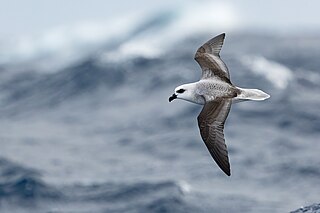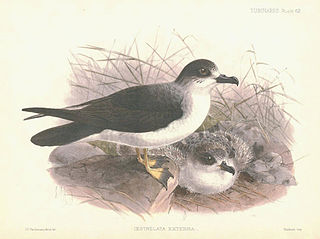
The gadfly petrels or Pterodroma are a genus of about 35 species of petrels, part of the seabird order Procellariiformes. The gadfly petrels are named for their speedy weaving flight, as if evading gadflies (horseflies). The flight action is also reflected in the name Pterodroma, from Ancient Greek pteron, "wing" and dromos, "runner".

The Fea's petrel is a small seabird in the gadfly petrel genus, Pterodroma. It was previously considered to be a subspecies of the soft-plumaged petrel, but they are actually not closely related at all. However, P. feae is very closely related to Zino's petrel and Desertas petrel, two other species recently split from P. mollis. The gadfly petrels are named for their speedy weaving flight, as if evading horseflies. The flight action is also reflected in the genus name Pterodroma, from Ancient Greek pteron, "wing" and dromos, " runner". This species is named after the Italian zoologist Leonardo Fea (1852-1903).

Zino's petrel or the freira, is a species of small seabird in the gadfly petrel genus, endemic to the island of Madeira. This long-winged petrel has a grey back and wings, with a dark "W" marking across the wings, and a grey upper tail. The undersides of the wings are blackish apart from a triangle of white at the front edge near the body, and the belly is white with grey flanks. It is very similar in appearance to the slightly larger Fea's petrel, and separating these two Macaronesian species at sea is very challenging. It was formerly considered to be a subspecies of the soft-plumaged petrel, P. mollis, but they are not closely related, and Zino's was raised to the status of a species because of differences in morphology, calls, breeding behaviour and mitochondrial DNA. It is one of Europe's most endangered seabirds, with breeding areas restricted to a few ledges high in the central mountains of Madeira.

The Kerguelen petrel is a small slate-grey seabird in the family Procellariidae. It is the only species placed in the genus Aphrodroma. It is a pelagic, circumpolar seabird of the Southern Ocean. It breeds on islands in the southern Atlantic and Indian Oceans.

Cook's petrel, or the tītī or blue-footed petrel, is a Procellariform seabird. It is a member of the gadfly petrels and part of the subgenus Cookilaria Bonaparte, 1856, which includes the very similar Stejneger's petrel.

The Bonin petrel or nunulu is a seabird in the family Procellariidae. It is a small gadfly petrel that is found in the northwest Pacific Ocean. Its secretive habits, remote breeding colonies and limited range have resulted in few studies and many aspects of the species' biology are poorly known.

The great-winged petrel is a petrel living and breeding in the world's Southern Ocean.

The Tahiti petrel is a medium-sized, dark brown and white seabird found across the Pacifc Ocean. The species comprises two subspecies: P. r. rostrata which breeds in the west-central Pacific Ocean, and P. r. trouessarti which breeds in the tropical and subtropical Pacific Ocean. The Tahiti petrel belongs to the Procellariidae family and is the most studied member of the Pseudobulweria genus which comprises three critically endangered species. Similarly, the Tahiti petrel is considered near threatened by the 2018 IUCN Red List of Threatened Species. Threats include introduced rats, feral cats, pigs, dogs, nickel mining, and light pollution.

The white-necked petrel, also known as the white-naped petrel, is a species of seabird in the family Procellariidae. During the non-breeding season it occurs throughout a large part of the Pacific, but it is only known to breed on Macauley Island in New Zealand's Kermadec Islands and the Australian territory of Norfolk Island and Phillip Island. It formerly bred on Raoul Island, but has now been extirpated from this locality. Reports of breeding on Merelava, Vanuatu, are more likely to be the very similar Vanuatu petrel, P. occulta, which some consider to be a subspecies of the white-necked petrel. The IUCN rating as vulnerable is for the "combined" species.

The Juan Fernández petrel is a species of seabird in the family Procellariidae. It nests on a single island off the coast of Chile, in the Juan Fernández Archipelago. It was previously classified as a subspecies of the white-necked petrel, which is found in tropical waters of the Pacific and Indian Oceans.

Gould's petrel is a species of seabird in the family Procellariidae. The common name commemorates the English ornithologist and bird artist John Gould (1804–1881).

The soft-plumaged petrel is a species of seabird in the family Procellariidae.

The Kermadec petrel is a species of gadfly petrel in the family Procellariidae. It is 38 cm long with a wingspan of 100 cm. It is polymorphic, with light, dark and intermediate morphs known. It eats squid, fish and other marine creatures.

The black-winged petrel is a species of seabird in the family Procellariidae. It breeds on a number of oceanic islands in the tropical and subtropical East Pacific Ocean and spends the rest of the year at sea.

Pycroft's petrel is a species of seabird in the petrel and shearwater family Procellariidae.

The grey-faced petrel is a species of petrel endemic to the North Island of New Zealand. In New Zealand it is also known by its Māori name ōi and as a muttonbird.
The Vanuatu petrel or Falla's petrel is a species of gadfly petrel. This little-known seabird was first scientifically described in 2001 based on six specimens taken in 1927 off Merelava, Vanuatu, and a single bird found ashore in 1983 in New South Wales, Australia. The first confirmed breeding locality was only discovered in 2009 on the island of Vanua Lava, Vanuatu, but based on reports by locals it is supposed to also breed on Merelava. The IUCN has not recognized the Vanuatu petrel as a species, but maintain that it as a subspecies of the very similar white-necked petrel, P. cervicalis, with the "combined" species considered vulnerable.
The Desertas petrel is a small seabird in the gadfly petrel genus which breeds on Bugio Island in the Desertas off Madeira. The gadfly petrels in the genus Pterodroma are seabirds of temperate and tropical oceans. Many are little-known, and their often similar appearance have caused the taxonomy of the group to be rather fluid. Although the systematics on this species has not yet been definitively established, provisionally some authorities have split the Desertas petrel, separating the Desertas breeding birds from those in the Cape Verde archipelago, while others consider it a subspecies of the Fea's petrel. The species is named after its breeding grounds, which are pronounced "Dez-ERT-ass".

The Herald petrel is a species of seabird and a member of the gadfly petrels. Its range includes the south Pacific Ocean and Indian Ocean.


















